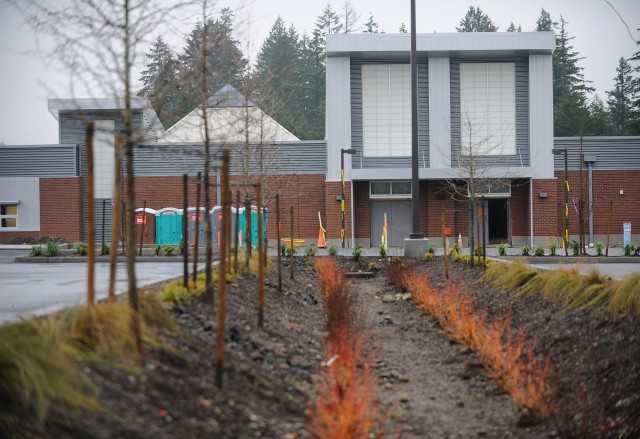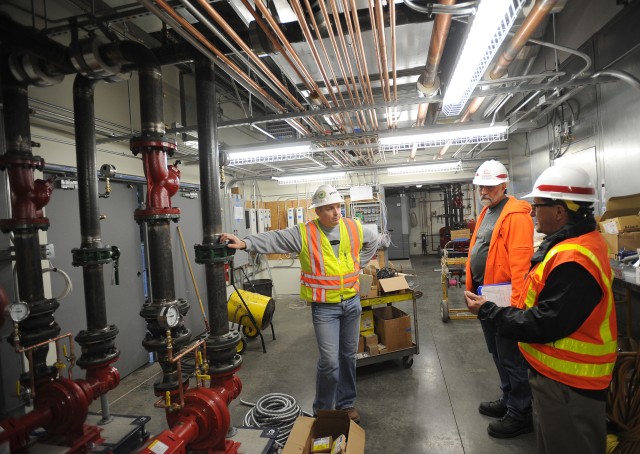FORT LEWIS, Wash. - Imagine a world where your home or business could produce more energy than it used.
How many groceries could you buy or how many children could you send to college if you got a credit every month on your electricity bill and it didn't cost you anything to heat your water and your home'
Believe it or not, the technology to create an energy-independent lifestyle already exists, and the Army is pioneering ways for it to become a reality, in part through its strict green building standards. With the adoption of the U.S. Green Building Council's Leadership in Energy Efficient and Environmental Design ratings system in 2008, the Army now requires nearly all new construction projects to achieve a minimum LEED Silver rating.
LEED is an internationally recognized green building certification system, providing third-party verification that a building or community was designed and built using strategies aimed at improving performance across all the following metrics: energy savings, water efficiency, CO2 emissions reduction, improved indoor environmental quality, and stewardship of resources and sensitivity to their impacts.
To meet LEED certification standards, a building has to attain points for design and construction elements that maximize efficiency, are innovative, encourage sustainability, and use resources made from recycled products.
Richard Sanchez, a project engineer for the U.S. Army Corps of Engineers, is working with contractors to meet those requirements at the Madigan Army Medical Center's new medical dental clinic near the 201st Battlefield Surveillance Brigade headquarters building.
Sanchez, who has spent the past 20 years working in sustainable design, believes green building technology is here to stay. Current photovoltaic and geothermal technologies have the capability to put power back into the grid, but their upfront cost can be intimidating, he said.
"If we progressively evolve 'green building' to the next level, we could achieve energy independence in a relativity short period of time," he said.
The new clinic is an example of how green building is on the way to becoming mainstream. Even though it costs several hundred thousand dollars more to meet LEED standards, the Army is committed to making sure the $18 million facility is "green."
According to Sanchez, if you combine current and future energy costs alongside the energy savings that is a part of the new technology, the increased cost will pay for itself in 10 years.
Sustainable design aspects extend outside the building and include an irrigation-free landscape designed to feed rainwater back into the aquifer and bike racks to encourage alternate transportation use. The building itself is predominantly constructed from materials that have a life cycle beyond their present function.
"Metal is one of the only materials that can be recycled indefinitely," said Sanchez.
The 42,194-square-foot building's shell is made of metal studs covered by a brick and metal faAfASade. It's lined with a vapor barrier and insulation that allows the building to exceed minimum energy efficiency standards. To reduce heat absorption, the outside is finished with reflective, cool-colored materials and paints.
According to Sanchez, one of the clinic's biggest energy savers lies at its complex air heating and cooling system. The living-room-size four-pipe boiler-chiller exchange uses significantly less energy than conventional systems to maintain comfort levels.
Inside the building, low-chemical paints and furnishings make the indoor environment practically toxin free. And all the carpet, vinyl tiles and drywall are comprised of recycled materials.
Contractors have worked to build efficiently, by setting a Korte team goal to recycle or salvage a minimum of 50 percent of construction, demolition and packaging debris.
"On this particular job, right now we have recycled construction materials in excess of 95 percent," said Brandon Davis, a Korte Construction quality control manager. "Any waste products are going back into other construction projects or to be made into materials again."
Resourceful practices like that earn the project extra LEED points.
Based on their homework and documentation, Davis and Sanchez are confident the project has enough sustainability points to surpass the minimum Silver standard and earn a LEED Gold rating. Korte has committed to provide the necessary funding to apply for LEED Gold certification.
If certified, it would be the first LEED Gold certified building on Fort Lewis and the first LEED Gold for an Army medical dental facility nationally.
Ingrid Barrentine is a photojournalist with Fort Lewis' Northwest Guardian.




Social Sharing